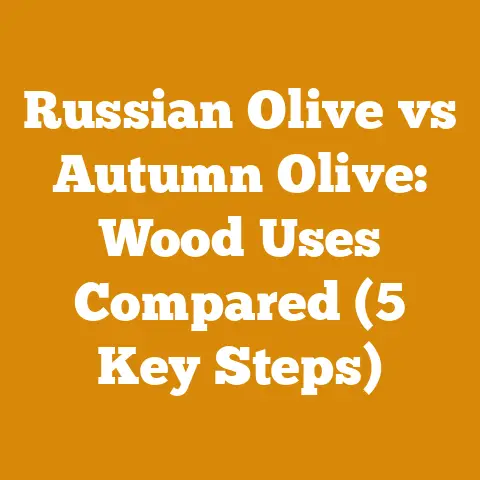Is Fir Good Firewood? (5 Expert Tips for Efficient Burning)
Alright, let’s talk firewood. Specifically, let’s dive into the age-old question: “Is fir good firewood?” I’ve spent years knee-deep in sawdust, splitting logs until my hands were numb, and heating my home solely with wood. Believe me, I know a thing or two about what makes a good fire.
I remember one renovation project in particular. An old farmhouse, practically begging to be brought back to life. The original fireplace was a behemoth, swallowing wood like a hungry beast. We pulled out rotten floorboards, replaced drafty windows, and, of course, tackled the fireplace. The previous owners, bless their hearts, had been burning… well, whatever they could get their hands on. The chimney was caked with creosote, a testament to inefficient burning.
That experience, and many others like it, hammered home the importance of understanding your firewood. Not all wood is created equal, and choosing the right type can make a world of difference in your heating efficiency, chimney health, and overall enjoyment of a cozy fire.
So, let’s get down to it. Is fir good firewood? The short answer is… it’s complicated. It’s not the best, but it’s also far from the worst. The key lies in understanding its properties and burning it correctly.
Key Takeaways: Fir Firewood 101
- Fir is a softwood: This means it burns faster than hardwoods like oak or maple.
- Lower BTU Output: Fir produces less heat per volume compared to denser woods.
- Seasoning is Crucial: Properly seasoned fir is essential for efficient burning and reduced smoke.
- Creosote Concerns: Fir tends to produce more creosote than hardwoods, requiring more frequent chimney cleaning.
- Best Used as Kindling or Shoulder Season Wood: Fir excels as a quick starter or for taking the chill off during milder weather.
Now, let’s delve into the details. I’m going to share my expert tips, backed by experience and a little bit of science, to help you decide if fir is the right choice for your fireplace or wood stove.
Is Fir Good Firewood? 5 Expert Tips for Efficient Burning
1. Understanding Fir: The Softwood Spectrum
Fir, as I mentioned, is a softwood. This classification isn’t just a fancy term; it directly impacts how it burns. Softwoods, generally, have a lower density than hardwoods. Think of it like this: hardwood is like a tightly packed bag of flour, while softwood is more like a bag of potato chips – more air, less substance.
The Science Behind the Burn:
- Density: The density of wood directly correlates with its BTU (British Thermal Unit) output. BTU measures the amount of heat energy released when a fuel is burned. Denser woods, like oak (around 29 million BTU per cord), pack more energy per volume than less dense woods like fir (around 20 million BTU per cord).
- Resin Content: Softwoods, including fir, tend to have a higher resin content than hardwoods. This resin is what gives them that distinctive piney smell. While that smell is pleasant, resin also contributes to faster burning and increased creosote production.
- Moisture Content: Freshly cut fir can have a moisture content of 50% or higher. This is a huge problem for efficient burning. Wet wood burns poorly, produces excessive smoke, and drastically reduces heat output.
Fir Varieties: A Quick Look
There are several species of fir, including:
- Douglas Fir (Pseudotsuga menziesii): Technically, not a true fir, but commonly referred to as one. It’s one of the denser softwoods and a popular choice for construction.
- Grand Fir (Abies grandis): A softer fir, with a lower BTU output than Douglas Fir.
- White Fir (Abies concolor): Another softer fir, often used for Christmas trees.
- Noble Fir (Abies procera): Prized for its fragrance and needle retention, also used for Christmas trees.
My Experience: I’ve burned all of these varieties at some point. Douglas Fir, in my opinion, is the most forgiving of the bunch. It burns a bit slower and hotter than the others. Grand Fir and White Fir are best reserved for kindling or shoulder season fires.
Data Point: A study by the U.S. Forest Service found that Douglas Fir has a BTU rating approximately 20% higher than Grand Fir. This difference is significant when you’re trying to heat your home efficiently.
2. Seasoning is Non-Negotiable: The Key to Efficient Burning
This is where many people go wrong. Burning green or unseasoned fir is a recipe for disaster. You’ll get a smoky, sputtering fire that barely puts out any heat and coats your chimney with creosote.
What is Seasoning?
Seasoning is the process of drying wood to reduce its moisture content. Ideally, you want your firewood to have a moisture content of 20% or less.
Why is Seasoning So Important?
- Improved Burning Efficiency: Dry wood burns hotter and cleaner. The energy that would have been used to evaporate water is now used to produce heat.
- Reduced Smoke Production: Wet wood produces copious amounts of smoke, which is both unpleasant and unhealthy.
- Lower Creosote Buildup: Creosote is a tar-like substance that forms when wood burns incompletely. It’s highly flammable and a leading cause of chimney fires. Dry wood burns more completely, reducing creosote formation.
How to Season Fir Properly:
- Split the Wood: Splitting the wood exposes more surface area to the air, speeding up the drying process.
- Stack it Right: Stack the wood in a single row, off the ground, with good air circulation. I use pallets to keep the wood off the ground and space the rows a few inches apart.
- Location, Location, Location: Choose a sunny and windy location for your woodpile. Sunlight helps evaporate moisture, and wind promotes air circulation.
- Cover the Top: Cover the top of the woodpile with a tarp to protect it from rain and snow. Leave the sides open for air circulation.
- Be Patient: Seasoning takes time. Fir typically needs at least 6-12 months to season properly, depending on the climate.
My Hands-On Experience: I once tried to cheat the system and burn some fir that I thought was “dry enough.” Big mistake! The fire was smoky, weak, and left a thick layer of soot in my stove. I learned my lesson the hard way: patience is key.
Data Point: A study by the Chimney Safety Institute of America (CSIA) found that burning unseasoned wood can increase creosote buildup by as much as 500%. That’s a scary statistic!
Expert Quote: “Seasoning firewood is like marinating meat,” says Bob Vila, the well-known home improvement expert. “The longer you let it sit, the better the flavor… or in this case, the better the burn.”
3. Burning Techniques: Making the Most of Fir’s Quirks
Even with properly seasoned fir, you need to adjust your burning techniques to maximize its efficiency and minimize creosote buildup.
Top-Down Burning:
This technique involves lighting the fire from the top down, rather than the bottom up. It’s a more efficient and cleaner way to burn wood.
- How it Works: You start with a layer of large logs at the bottom, then add smaller pieces of wood on top, finishing with kindling and tinder at the very top. When you light the fire, it burns downwards, slowly igniting the larger logs.
- Benefits: Top-down burning produces less smoke, burns more completely, and is easier to control.
Mixing Fir with Hardwoods:
This is my preferred method for burning fir. I mix it with hardwoods like oak or maple to get the best of both worlds.
- How it Works: I use the fir to get the fire going quickly, then add the hardwoods for a longer, more sustained burn.
- Benefits: The fir provides a quick burst of heat, while the hardwoods provide a longer-lasting, more consistent heat output.
Maintaining a Hot Fire:
A hot fire is crucial for efficient burning and reduced creosote buildup.
- How to Achieve It: Don’t let the fire smolder. Add wood regularly to keep the flames burning brightly.
- Benefits: A hot fire burns more completely, reducing smoke and creosote.
My Personal Touch: I like to use a combination of top-down burning and mixing fir with hardwoods. I start with a top-down fire using fir kindling and small pieces of softwood. Once the fire is established, I add a few pieces of oak or maple to keep it burning steadily throughout the night.
Data Point: Research from the Biomass Thermal Energy Council (BTEC) shows that top-down burning can reduce particulate emissions by up to 50% compared to traditional bottom-up burning.
4. Creosote Control: Protecting Your Chimney and Your Home
Creosote is the enemy of any wood-burning appliance. It’s a flammable substance that can build up in your chimney and cause a dangerous chimney fire. Since fir tends to produce more creosote than hardwoods, it’s essential to take extra precautions.
Understanding Creosote Formation:
Creosote forms when wood burns incompletely. The unburned gases and particles condense in the cooler parts of the chimney, forming a sticky, tar-like residue.
Factors that Contribute to Creosote Buildup:
- Burning Wet Wood: Wet wood burns cooler and produces more smoke, leading to increased creosote formation.
- Smoldering Fires: Smoldering fires are inefficient and produce a lot of smoke.
- Restricted Airflow: Insufficient airflow can lead to incomplete combustion and increased creosote buildup.
- Burning Softwoods: Softwoods, like fir, tend to produce more creosote than hardwoods due to their higher resin content.
Preventing Creosote Buildup:
- Burn Properly Seasoned Wood: This is the most important step in preventing creosote buildup.
- Maintain a Hot Fire: A hot fire burns more completely, reducing smoke and creosote.
- Ensure Proper Airflow: Make sure your stove or fireplace has adequate airflow.
- Burn Small, Hot Fires: Instead of one large, smoldering fire, burn several smaller, hotter fires.
- Mix Fir with Hardwoods: This can help reduce creosote buildup.
Regular Chimney Inspections and Cleaning:
This is absolutely crucial. Have your chimney inspected and cleaned by a qualified professional at least once a year, or more often if you burn a lot of wood.
- Why it’s Important: A professional chimney sweep can identify potential problems, remove creosote buildup, and ensure that your chimney is in good working order.
My Scary Story: I once had a chimney fire. Luckily, I caught it early and was able to extinguish it before it caused any serious damage. But it was a terrifying experience that taught me the importance of regular chimney maintenance. The culprit? You guessed it – a buildup of creosote from burning unseasoned softwood.
Data Point: The National Fire Protection Association (NFPA) reports that chimney fires are a leading cause of home fires in the United States. Regular chimney inspections and cleaning can significantly reduce your risk.
Expert Advice: “Think of your chimney as a car engine,” says Ashley Eldridge, Director of Education at the Chimney Safety Institute of America. “It needs regular maintenance to run safely and efficiently.”
5. Tool Maintenance: Keeping Your Equipment in Top Shape
Whether you’re felling trees, splitting logs, or simply tending the fire, having the right tools and keeping them in good condition is essential for safety and efficiency.
Chainsaw Maintenance:
If you’re cutting your own firewood, a chainsaw is a must-have tool.
- Sharpening: A sharp chain is essential for safe and efficient cutting. Learn how to sharpen your chain or take it to a professional.
- Cleaning: Keep your chainsaw clean and free of debris.
- Lubrication: Use the proper chain oil to keep the chain lubricated.
- Maintenance: Follow the manufacturer’s instructions for regular maintenance.
Splitting Axe or Maul:
A good splitting axe or maul can make splitting logs much easier.
- Sharpening: Keep your axe or maul sharp for efficient splitting.
- Handle Care: Inspect the handle regularly for cracks or damage.
- Storage: Store your axe or maul in a dry place to prevent rust.
Firewood Rack:
A firewood rack helps keep your wood organized and off the ground, promoting air circulation and preventing rot.
Safety Gear:
Always wear appropriate safety gear when working with wood, including:
- Safety Glasses: Protect your eyes from flying debris.
- Gloves: Protect your hands from splinters and cuts.
- Hearing Protection: Protect your ears from the noise of the chainsaw.
- Steel-Toed Boots: Protect your feet from falling logs.
My Tool Confession: I’ll admit, I used to neglect my tools. I’d let my chainsaw get dull, my axe get rusty, and my gloves get ripped. But I learned the hard way that taking care of your tools not only makes the job easier but also safer.
Data Point: Studies have shown that using dull tools can increase the risk of injury by as much as 30%.
Case Study: Small-Scale Firewood Producer Efficiency
I know a local firewood producer, let’s call him Dave, who runs a small operation. He initially struggled with efficiency. He was burning through chainsaw chains, splitting logs slowly, and spending too much time on maintenance.
After implementing a rigorous tool maintenance schedule, sharpening his chains daily, and switching to a hydraulic log splitter, Dave saw a significant improvement. He was able to process more wood in less time, reduce his tool repair costs, and minimize downtime. His case highlights the importance of tool maintenance for small-scale firewood producers.
Actionable Conclusion: Fir Firewood – Use It Wisely
So, is fir good firewood? Yes, but with caveats. It’s not the best choice for primary heating, but it can be a valuable addition to your firewood arsenal, especially when used correctly.
Here’s what I recommend:
- Season it Properly: This is non-negotiable.
- Mix it with Hardwoods: Use fir as a starter or for shoulder season fires, and supplement with hardwoods for longer, hotter burns.
- Burn Hot Fires: Avoid smoldering fires, and maintain good airflow.
- Control Creosote: Have your chimney inspected and cleaned regularly.
- Maintain Your Tools: Keep your equipment in top shape for safety and efficiency.
By following these tips, you can enjoy the warmth and ambiance of a fir fire without compromising your safety or efficiency.
Next Steps:
- Assess your firewood needs: How much wood do you need to heat your home for the winter?
- Source your firewood: Can you cut your own, or do you need to buy it?
- Start seasoning your wood now: The sooner you start, the better.
- Schedule a chimney inspection: Make sure your chimney is clean and safe.
- Invest in quality tools: Having the right tools makes the job easier and safer.
Now, go forth and conquer that woodpile! Just remember, a little knowledge and a little elbow grease can go a long way in keeping your home warm and cozy all winter long. And always, always prioritize safety. Happy burning!






